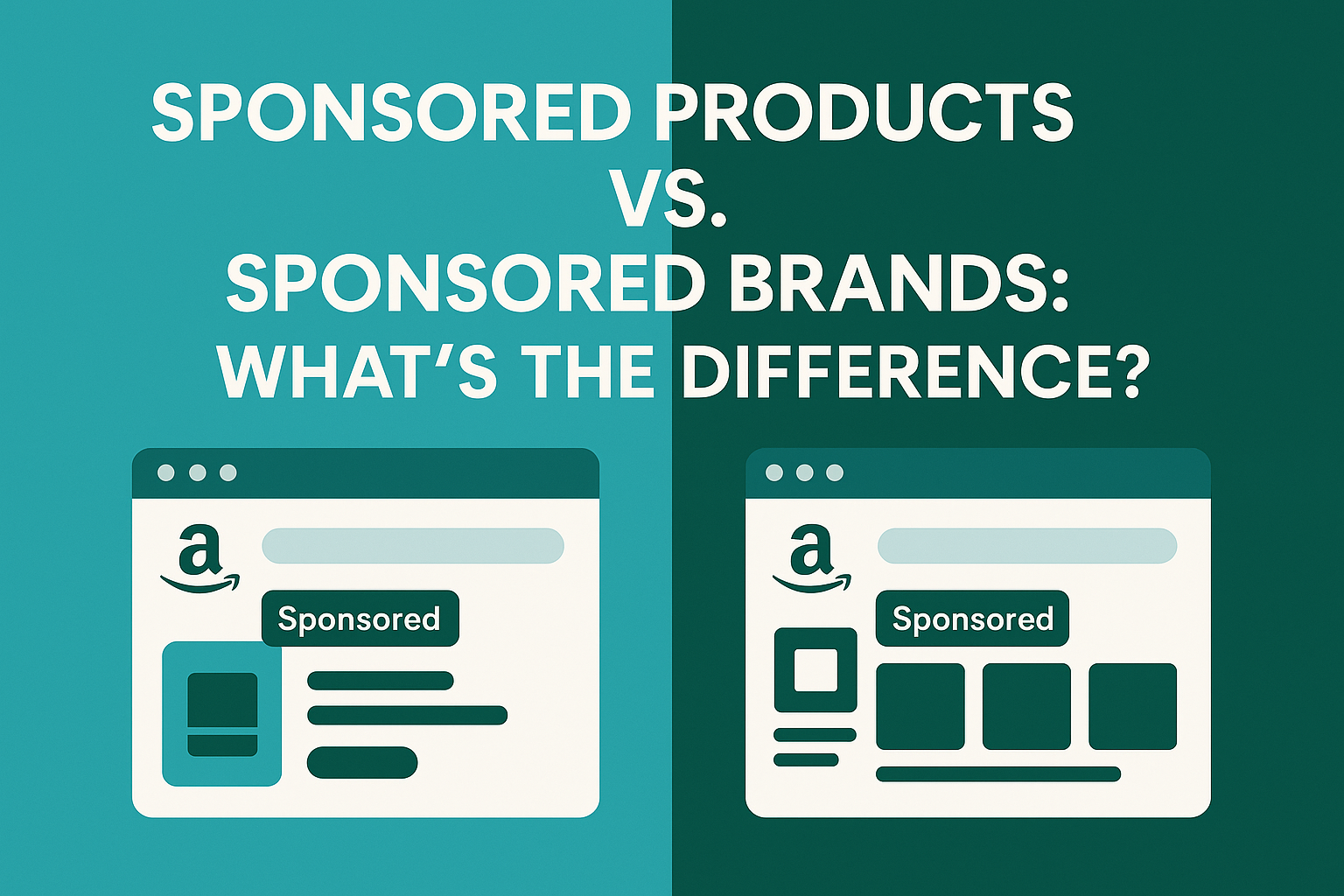Introduction: Why Amazon Sponsored Ads Matter More Than Ever
In 2025, Amazon is more competitive than ever. With more sellers launching each day and customer attention becoming harder to capture, paid advertising has evolved from a growth tool to a necessity. Two of the most powerful options available to sellers are Amazon Sponsored Products and Amazon Sponsored Brands.
But while they’re both part of the Amazon Sponsored Ads ecosystem, they serve very different purposes. Understanding how and when to use each type can mean the difference between stagnant sales and sustained growth.
This guide is designed for new and growing brands looking to navigate this choice strategically. We’ll walk you through the key differences between Sponsored Products and Sponsored Brands, help you understand how each fits into your growth strategy, and explain how to analyze your competition to stay ahead in the advertising game.
Understanding Amazon Sponsored Products
What Are Sponsored Products?
Amazon Sponsored Products are pay-per-click (PPC) ads that promote individual products. These ads appear in search results, on product detail pages, and in various placements across the Amazon ecosystem. They’re triggered by keywords or product targeting and are available to most sellers with a Professional account.
Sponsored Products are the backbone of many ad strategies because they’re performance-driven and optimized for conversions. If your goal is to drive direct sales quickly and consistently, this is the ad format to start with.
How Do Sponsored Products Work?
These ads target customer search queries or specific ASINs. You pay when someone clicks your ad. Amazon’s algorithm determines placement based on a combination of your bid, ad relevance, and historical performance.
There are two targeting types:
- Automatic targeting, where Amazon selects keywords based on your listing content.
- Manual targeting, where you choose keywords, match types, or ASINs to target.
When to Use Sponsored Products
Sponsored Products are ideal when you:
- Want to promote a specific SKU.
- Need to quickly boost traffic to a new or seasonal item.
- Are launching a product and need data for future campaigns.
- Want to target specific competitors or keywords.
Understanding Amazon Sponsored Brands
What Are Sponsored Brands?
Amazon Sponsored Brands (formerly Headline Search Ads) are also PPC ads, but they focus on promoting your brand rather than a single product. These ads display a custom headline, your logo, and up to three products. They appear at the top of search results—a premium placement.
To run Sponsored Brands, you must be enrolled in Amazon’s Brand Registry, giving you access to enhanced brand-building tools.
How Do Sponsored Brands Work?
Sponsored Brands allow keyword targeting and offer a few landing page options:
- Your Amazon Storefront.
- A custom landing page featuring selected products.
- A single product detail page.
Sponsored Brands have evolved to include video ads and Store Spotlight, which links directly to your Amazon Store’s subpages. These formats offer more visual real estate and storytelling opportunities than Sponsored Products.
When to Use Sponsored Brands
Sponsored Brands work best when you want to:
- Build brand awareness and visibility.
- Showcase your product portfolio.
- Drive traffic to your Amazon Store.
- Cross-sell complementary items.
- Control how your brand appears in search.
Key Differences: Sponsored Products vs. Sponsored Brands
To determine which ad type is right for your goals, you need to understand how these two compare across key dimensions:
| Feature | Sponsored Products | Sponsored Brands |
| Purpose | Drive direct product sales | Build brand awareness & cross-sell |
| Ad Format | One product with minimal design | Logo, headline, 3 products, video option |
| Targeting | Keywords, ASINs | Keywords only |
| Landing Page | Product detail page | Amazon Store or landing page |
| Eligibility | Open to all pro sellers with Buy Box eligibility | Requires Brand Registry |
| Conversion Focus | High | Moderate to high |
| Placement | Mid-page, detail pages | Top of search, Store Spotlight, video |
Understanding this structure is key when choosing the right campaign to invest in. If your main focus is product-level performance, Sponsored Products offer simplicity and efficiency. If your focus is brand storytelling, Sponsored Brands provide more visual control and higher funnel engagement.
How to Analyze Competitors Using Sponsored Ads
Before launching or adjusting your ad strategy, it’s essential to conduct a competitor analysis to see how other brands are using Sponsored Products and Sponsored Brands.
Step 1: Identify Your Direct Competitors
Start by searching your top keywords on Amazon and take note of:
- Who shows up in the Sponsored Products section.
- Which brands dominate Sponsored Brand banner placements.
- Which products repeatedly appear in ads.
Use this information to create a list of your top 5–10 competitors.
Step 2: Study Their Sponsored Products Strategy
Look at how your competitors:
- Price their advertised products.
- Use titles and images to attract attention.
- Appear under “Customers Also Bought” or “Sponsored Products related to this item.”
- Show up with Sponsored Product placements on your own listings.
Use tools like Helium 10 to analyze their keyword rankings, ad frequency, and estimated ad spend.
Step 3: Evaluate Their Sponsored Brands Strategy
Check if they:
- Use videos in their Sponsored Brands.
- Drive traffic to their Store or a custom landing page.
- Show complementary products together in their banners.
- Use seasonal messaging or evergreen campaigns.
Visit their Amazon Storefronts and evaluate how well they maintain a branded experience. Does their Store design match their ad messaging? Are they using category subpages? Do they update frequently?
This step gives you insight into how much branding investment they’re making—and whether you should match or differentiate.
Step 4: Observe Ad Timing and Budget Signals
Competitor ads may fluctuate by time of day or season. Use tracking tools like PPC Scope or Pacvue to analyze:
- Which times of day ads are most aggressive.
- How often they appear in top-of-search placements.
- Whether they use high-volume terms or long-tail keywords.
These patterns reveal how much they’re spending, which areas they prioritize, and where you might find gaps to compete.
Step 5: Map Their Funnel Strategy
Look at how competitors use a full-funnel strategy:
- Top of funnel (Sponsored Brands video to Store).
- Middle of funnel (branded keywords or complementary product ads).
- Bottom of funnel (retargeting or ASIN targeting with Sponsored Products).
By mapping their journey, you can reverse-engineer their objectives—whether they focus more on awareness, conversion, or loyalty—and adjust your own campaigns accordingly.
Building a Dual-Layer Advertising Strategy
Many successful Amazon brands use both Sponsored Products and Sponsored Brands in tandem. Here’s how to build a smart strategy using both:
- Start with Sponsored Products to:
- Collect performance data on keywords.
- Gain consistent traffic.
- Validate new product launches.
- Collect performance data on keywords.
- Layer in Sponsored Brands to:
- Reinforce brand presence.
- Cross-promote high-margin items.
- Increase repeat purchases via Store traffic.
- Reinforce brand presence.
- Test continuously. Use A/B testing across formats, targeting, and landing pages.
- Monitor metrics separately. Sponsored Products and Sponsored Brands serve different purposes, so compare metrics like:
- ROAS (return on ad spend)
- CTR (click-through rate)
- CVR (conversion rate)
- Brand lift or Store visits
- ROAS (return on ad spend)
Learn more about managing Amazon ads efficiently on our Advertising Management page.
Common Mistakes to Avoid
- Using only one ad format. You’ll miss out on full-funnel visibility if you rely solely on Sponsored Products or Brands.
- Ignoring your Store experience. Sponsored Brands are less effective if the Store is outdated or poorly designed.
- Over-focusing on branded keywords. These are often high-converting but may limit new customer acquisition.
- Not analyzing the competition. Blind bidding can waste ad budget if you don’t understand what similar brands are doing.
Avoiding these pitfalls is essential for building a sustainable and competitive Amazon advertising strategy.
Conclusion: Choosing the Right Amazon Ad Type for Your Brand
Understanding the difference between Amazon Sponsored Products and Sponsored Brands isn’t just about formats—it’s about aligning your ad strategy with your brand’s current stage and future goals.
- Use Sponsored Products for fast-moving, product-specific growth and keyword validation.
- Use Sponsored Brands for brand storytelling, multi-product promotion, and driving traffic to your Store.
By studying your competitors and crafting a well-rounded approach, you can not only improve your performance on Amazon—you can outpace sellers who don’t take a data-driven approach.
Need help refining your ad strategy or running a full competitor analysis?
Book a Call with our experts at Bits & Atoms to explore how we can help you grow smarter on Amazon.


